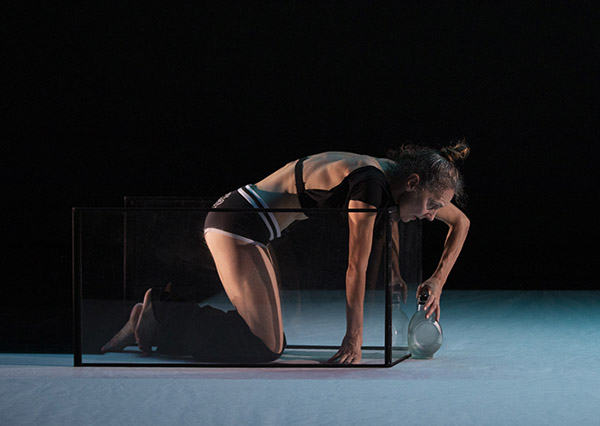Congruence 2-- Bouchardanse at the Winchester

Congruence 2
Presented by Bouchardanse
Co-produced with pounds per square inch, and with FILA 13 Productions
Winchester Street Theatre, Toronto
October 10-12, 2019
Woman in Blue Softly Breathing
Choreographed by Lina Cruz
Performed by Sylvie Bouchard
Reviewed by Beverley Daurio
A large white zig-zaggy, sharp-edged geometric shape provides the defined dance area on the floor under general light. At the front, a two-dimensional rectangle and three-dimensional triangular object add black contrast. Off to the right hangs a strange towering mobile made of wire and bottles, adding curves and verticality to the horizontal array of straight lines. The piece unfolds inside the limits of this dramatic and minimalist set by Cheryl Lalonde.
Sylvie Bouchard hops into view, her long brown hair in a knot atop her head, wearing a sleeveless shirt and loose round-legged pants, bopping, bowlegged a bit, and somewhat startled. She is carrying a bottle with clear liquid in it, and pitter patters around the defined playing area as if she has just discovered herself in a strange place, bemused and curious, exploring.
Woman in Blue Softly Breathing is based out of a painting, or possibly two paintings of the same name by Picasso, in English titled “The Absinthe Drinker”—one of a Blue Period woman sleep-dreaming at a table in a bar, eyes closed, and the other of a woman with her brown hair in a knot on her head, with a bottle and a glass before her, sitting at a table, clearly in a marvellous café that embodies a certain atmosphere of European cosmopolitanism and artistic intensity.
It is interesting how Cruz never presents Bouchard’s character as a living person: she is manifesting a character from the inside of a painting before that painting has materialized. In a complex way, she is both the creator and the subject. She wanders, moves and dances among the flotsam and bits of a potential painting until she discovers how to manipulate the shapes into forms she (the absinthe drinker) can use, that will hold her up, that will create a form that beautifully solves the disarray of the original set and changes it into a formal, finished, wonderful meaningful-to-the-audience image.
The soundscape offers a nicely unpredictable avant-garde background to Bouchard’s often acrobatic and daring travels through the piece, from tinkling piano to bass beats to Bouchard blowing into the bottle she carries throughout the piece to create sounds.
Cruz, with Bouchard as her agent of magic, takes us inside the artistic process, and leads us, gently and wisely and with a lot of fun and strange moments, as Bouchard’s “character” discovers the puzzle pieces of the live “painting”, and begins to find ways to amend them and put them together. This series of explorations and discoveries forms the core of the piece, and it is a testament to Cruz’s design that we cannot predict or grasp the finished “picture” in advance, but are inculcated into the process of discovery itself. We are as surprised as the acrobatic, balancing and entrancing Sylvie Bouchard when suddenly all the parts fit and the work suddenly coheres.

Gravity of Descent
Choreography/Concept/Text by Gerry Trentham
Performed by Sylvie Bouchard and Learie McNicolls
Gerry Trentham’s Gravity of Descent also opens with an impressive and imaginatively dominating set also by Cheryl Lalonde: Sylvie Bouchard stands still as a statue, wearing one silver shoe (the other is closer to us on the floor) and draped in a fluffy white dress (that we later learn is made of paper) at the waist of a giant white cloth skirt, which is lying on the floor and radiating outward, covering more than half the stage. To her right, Learie McNicolls sits on a wooden chair then stands, dressed conservatively in a sweater vest and pants and brown leather shoes, near a strange rectangular contraption on the floor, that later gives out light and pours down measured sand, into and through his hands.
Bouchard and McNicolls have commanding presences. They are separate in their spaces yet manage to convey a powerful tension between them. They are individuals, yet at the same time produce auras of femininity and masculinity that are at once recognizable, purposefully gender-cliched, and archetypal.
The score, like the occasional extra lighting effects—for example, a spot on McNicolls as sand pours down from above and through his hands—is spare and for emphasis. Pings and noises occur from time to time. Bouchard recites poetic lyrics—“blackbirds in the air”—that repeat again toward the end of the piece and give a southern gothic feeling.
McNicolls slowly divests himself of most of his clothing, moving as if drawn by magnetism toward Bouchard and the white cloths. For her part, Bouchard slowly rustles toward us, eventually removes her white paper dress, which gains a kind of insincerity and falseness the closer she gets to us. Is it not a wedding dress, is this not some kind of coming together of two people?
It is not. Time passes and they appear to confer, but they do not connect except in the same powerful and tense way, distantly. McNicolls, stripped to his underwear, in molasses-like but strong movements, becomes entangled in the white cloth and puts on the dress discarded by Bouchard, as she, for her part, now dressed in a sleeveless sweater and pants, has abandoned the silver shoes.
There is something powerfully non-binary operating in the physical subtext of this piece, and Bouchard and McNicolls display and embody a transmutative humanness that Trentham has captured and held.

